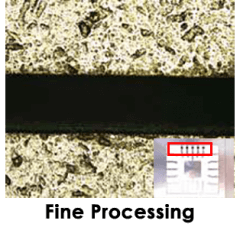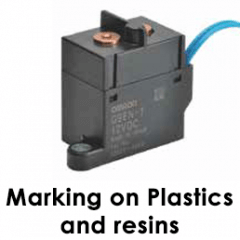Shop by Category
Omron MX-Z Laser Marker System
Laser marker engraves a wide range of materials and shapes in practically any industry
This high-performance laser marker is part of a turnkey solution that easily integrates with PLCs, vision systems for inspection and database systems for traceability. The MX-Z_H fiber laser marker delivers high speed, high-quality etching at today’s in-line production speeds. The ability to mark 3D objects and edit the processing data are standard built-in functionality. An energy enhancement option enables deep, high contrast marking without slowing down production.






Why choose Omron's Laser Marker?
The MX-Z20xxH series offering great performance to laser mark characters, company logos, drawings, images on a wide variety of materials (plastics, resins, metal or other materials). Mark flat surfaces, slanted, stepped, or three dimensional like spheres, cylinders or conical without a problem.
Simply stated, laser marking removes material to create depth or modify the material to change the color, contrast or reflectivity of the surface. Therefore, when it comes to etching permanent marks on products, Omron’s MX-Z laser marker leads the market with:
- The widest range of markable materials
- Long working distance
- Built-in 3D object marking capability
It easily integrates with a vision system for pre-marking object alignment, mark inspection, and tracking of marked objects. Build a traceability solution from SQL databases using a combination of laser marker and vision system input with an NJ Database machine automation controller.
3 Easy Configurations
Time-saving integration features that reduce overall solution cost.
- Direct Finder Link between laser marker and vision system, without a PLC managing signaling, reduces cycle time, increases productivity, reduces equipment required and reduces costs.
- All in One Vision Ready Adapter simplifies installation of the vision camera to align product before marking, verify what was laser marked and reduce the number of operations.
- Traceability system tracks what was laser marked for regulatory requirements and confirms data verified by the vision system. Then, inspection data is sent to an NJ501 or NJ101 Database controller with built-in SQL client. The SQL client then reports the data to enterprise systems for recordkeeping and fault analysis. Subsequently, this process helps shorten isolation of date/lot codes for timely recalls.
Advantages
Laser type: Omron chose the combination of Fiber, YAG and YV04 lasers for the MX-Z series to maximize flexibility in the range of compatible metal and resin materials. However, the only popular materials not supported are glass and PET. For those materials recommend a CO2 laser. Omron’s main competitor uses SHG type laser. While there are overlaps in marked material compatibility, Omron’s laser marker provides a higher quality mark at production speed.
Repetition rate: This determines the quality of the laser marking Cycle time; the shorter the repetition rate, the faster the laser marking. So a lower repetition rate not necessarily bad, however, our competitors can say that they are faster, but the quality will not be as good.
.png)

.png)